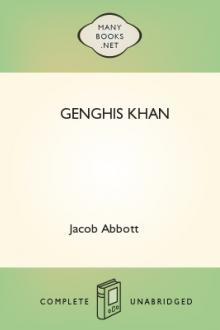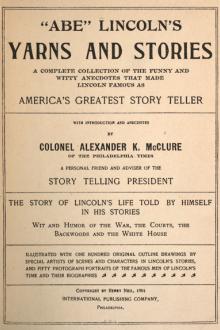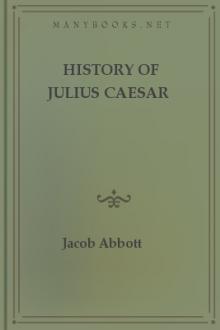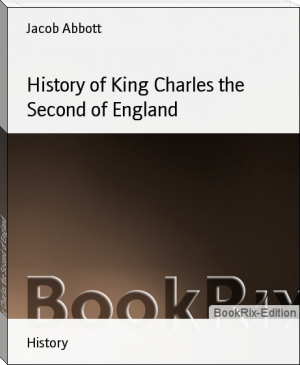Genghis Khan by Jacob Abbott (romantic novels in english .txt) 📕

- Author: Jacob Abbott
- Performer: -
Book online «Genghis Khan by Jacob Abbott (romantic novels in english .txt) 📕». Author Jacob Abbott
Such, substantially, was pastoral life in the beginning. In process of time, of course, the tribes banded together became larger and larger. Some few towns and cities were built as places for the manufacture of implements and arms, or as resting-places for the caravans of merchants in conveying from place to place such articles as were bought and sold. But these places were comparatively few and unimportant. A pastoral and roaming life continued to be the destiny of the great mass of the people. And this state of things, which was commenced on the banks of the Euphrates before the time of Abraham, spread through the whole breadth of Asia, from the Mediterranean Sea to the Pacific Ocean, and has continued with very little change from those early periods to the present time.
Genghis Khan.
Of the various chieftains that have from time to time risen to command among these shepherd nations but little is known, for very few and very scanty records have been kept of the history of any of them. Some of them have been famous as conquerors, and have acquired very extended dominions. The most celebrated of all is perhaps Genghis Khan, the hero of this history. He came upon the stage more than three thousand years after the time of the great prototype of his class, the Patriarch Abraham.
Chapter II. The Monguls.Origin of the name.
Three thousand years is a period of time long enough to produce great changes, and in the course of that time a great many different nations and congeries of nations were formed in the regions of Central Asia. The term Tartars has been employed generically to denote almost the whole race. The Monguls are a portion of this people, who are said to derive their name from Mongol Khan, one of their earliest and most powerful chieftains. The descendants of this khan called themselves by his name, just as the descendants of the twelve sons of Jacob called themselves Israelites, or children of Israel, from the name Israel, which was one of the designations of the great patriarch from whose twelve sons the twelve tribes of the Jews descended. The country inhabited by the Monguls was called Mongolia.
To obtain a clear conception of a single Mongul family, you must imagine, first, a rather small, short, thick-set man, with long black hair, a flat face, and a dark olive complexion. His wife, if her face were not so flat and her nose so broad, would be quite a brilliant little beauty, her eyes are so black and sparkling. The children have much the appearance of young Indians as they run shouting among the cattle on the hill-sides, or, if young, playing half-naked about the door of the hut, their long black hair streaming in the wind.
Like all the rest of the inhabitants of Central Asia, these people depended almost entirely for their subsistence on the products of their flocks and herds. Of course, their great occupation consisted in watching their animals while feeding by day, and in putting them in places of security by night, in taking care of and rearing the young, in making butter and cheese from the milk, and clothing from the skins, in driving the cattle to and fro in search of pasturage, and, finally, in making war on the people of other tribes to settle disputes arising out of conflicting claims to territory, or to replenish their stock of sheep and oxen by seizing and driving off the flocks of their neighbors.
The animals which the Monguls most prized were camels, oxen and cows, sheep, goats, and horses. They were very proud of their horses, and they rode them with great courage and spirit. They always went mounted in going to war. Their arms were bows and arrows, pikes or spears, and a sort of sword or sabre, which was manufactured in some of the towns toward the west, and supplied to them in the course of trade by great traveling caravans.
Although the mass of the people lived in the open country with their flocks and herds, there were, notwithstanding, a great many towns and villages, though such centres of population were much fewer and less important among them than they are in countries the inhabitants of which live by tilling the ground. Some of these towns were the residences of the khans and of the heads of tribes. Others were places of manufacture or centres of commerce, and many of them were fortified with embankments of earth or walls of stone.
The habitations of the common people, even those built in the towns, were rude huts made so as to be easily taken down and removed. The tents were made by means of poles set in a circle in the ground, and brought nearly together at the top, so as to form a frame similar to that of an Indian wigwam. A hoop was placed near the top of these poles, so as to preserve a round opening there for the smoke to go out. The frame was then covered with sheets of a sort of thick gray felt, so placed as to leave the opening within the hoop free. The felt, too, was arranged below in such a manner that the corner of one of the sheets could be raised and let down again to form a sort of door. The edges of the sheets in other places were fastened together very carefully, especially in winter, to keep out the cold air.
Within the tent, on the ground in the centre, the family built their fire, which was made of sticks, leaves, grass, and dried droppings of all sorts, gathered from the ground, for the country produced scarcely any wood. Countries roamed over by herds of animals that gain their living by pasturing on the grass and herbage are almost always destitute of trees. Trees in such a case have no opportunity to grow.
Comfortless homes.
The tents of the Monguls thus made were, of course, very comfortless homes. They could not be kept warm, there was so much cold air coming continually in through the crevices, notwithstanding all the people's contrivances to make them tight. The smoke, too, did not all escape through the hoop-hole above. Much of it remained in the tent and mingled with the atmosphere. This evil was aggravated by the kind of fuel which they used, which was of such a nature that it made only a sort of smouldering fire instead of burning, like good dry wood, with a bright and clear flame.
The discomforts of these huts and tents were increased by the custom which prevailed among the people of allowing the animals to come into them, especially those that were young and feeble, and to live there with the family.
The painting.
In process of time, as the people increased in riches and in mechanical skill, some of the more wealthy chieftains began to build houses so large and so handsome that they could not be conveniently taken down to be removed, and then they contrived a way of mounting them upon trucks placed at the four corners, and moving them bodily in this way across the plains, as a table is moved across a floor upon its castors. It was necessary, of course, that the houses should be made very light in order to be managed in this way. They were, in fact, still tents rather than houses, being made of the same materials, only they were put together in a more substantial and ornamental manner. The frame was made of very light poles, though these poles were fitted together in permanent joinings. The covering was, like that of the tents, made of felt, but the sheets were joined together by close and strong seams, and the whole was coated with a species of paint, which not only closed all the pores and interstices and made the structure very tight, but also served to ornament it; for they were accustomed, in painting these houses, to adorn the covering with pictures of birds, beasts, and trees, represented in such a manner as doubtless, in their eyes, produced a very beautiful effect.
These movable houses were sometimes very large. A certain traveler who visited the country not far from the time of Genghis Khan says that he saw one of these structures in motion which was thirty feet in diameter. It was drawn by twenty-two oxen. It was so large that it extended five feet on each side beyond the wheels. The oxen, in drawing it, were not attached, as with us, to the centre of the forward axle-tree, but to the ends of the axle-trees, which projected beyond the wheels on each side. There were eleven oxen on each side drawing upon the axle-trees. There were, of course, many drivers. The one who was chief in command stood in the door of the tent or house which looked forward, and there, with many loud shouts and flourishing gesticulations, issued his orders to the oxen and to the other men.
The household goods of this traveling chieftain were packed in chests made for the purpose, the house itself, of course, in order to be made as light as possible, having been emptied of all its contents. These chests were large, and were made of wicker or basket-work, covered, like the house, with felt. The covers were made of a rounded form, so as to throw off the rain, and the felt was painted over with a certain composition which made it impervious to the water. These chests were not intended to be unpacked at the end of the journey, but to remain as they were, as permanent storehouses of utensils, clothing, and provisions. They were placed in rows, each on its own cart, near the tent, where they could be resorted to conveniently from time to time by the servants and attendants, as occasion might require. The tent placed in the centre, with these great chests on their carts near it, formed, as it were, a house with one great room standing by itself, and all the little rooms and closets arranged in rows by the side of it.
Some such arrangement as this is obviously necessary in case of a great deal of furniture or baggage belonging to a man who lives in a tent, and who desires to be at liberty to remove his whole establishment from place to place at short notice; for a tent, from the very principle of its construction, is incapable of





Comments (0)